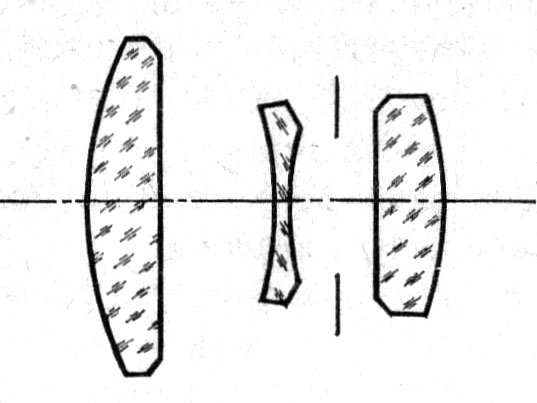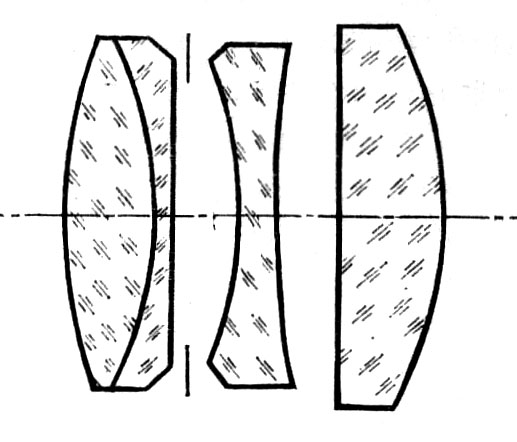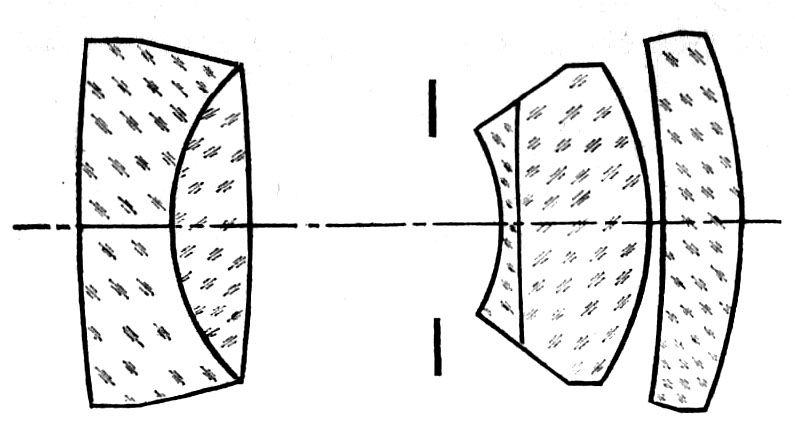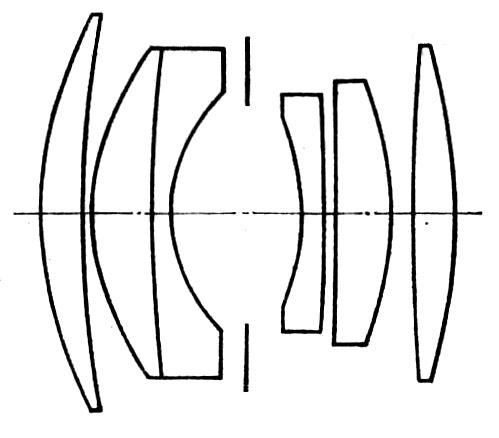LENSES IN SMALL SCREENS.
The construction of lenses used in 35mm reflex cameras is very diverse. The simplest are three-lens triplets (drawing), consisting of three separately built-in lenses.

Drawing. A three-lens triplet.
Lenses built in this way are very popular, cheap and easy to build. They give sharp enough images already at moderate obscuration. At full aperture their resolving power on the edges of the image is a bit lower than in more complicated lenses, but even at full aperture they give sharp enough images, to be greatly enlarged.
These include, among others, the Zeiss Triotar, Domiplan i Trioplan Meyera, Radionar Schneidera.
By replacing the back member of the triplet with two interconnected lenses, the Zeiss C. Rudolpha, and improved by E. Wandersleba i W. Merte Tessar lens. Currently, it is built in series with relative openings from 1 : 2,8 do 1 : 9 and is probably the most popular lens in the world (drawing).

Drawing. Tessar Zeissa 2,8/50 mm.
Elmar Leitz are also based on this principle, solinar agfa, Primotar Meyera, Anticomar Plaubla, Xenar Schneidera, Soviet Industry 22, 26 i 50. In triplets of this type, one lens element is glued from two lenses, and the other two consist of one free-standing lens each. Lenses of this type are probably the most widespread as universal in brightness 1 : 2,8, 1 : 3,5 i 1 : 4,5 and they have different focal lengths.
A further development of this construction are systems of five- and seven-lens (drawing) of a very complex structure, but always based on the triplet principle (tripartite), regardless of whether the individual lenses are freestanding, or glued.

Drawing. Five-lens triplet (Sonnar Zeissa 4,8/180 mm).
These include, among others: Heliar Voigtlandera, Primoplan Meyera, Sonnar Zeiss and Soviet: Jupiter 3 i 8 as well as Helios 40, 44 i S 44.
Objectives symmetrically composed of two multi-lens elements, each of which is a standalone lens, generally not used in modern 35mm cameras, because the use of interchangeable lenses did, that the use of lens halves for a double focal length is unnecessary. In addition, the design of a 35mm reflex camera without a variable bellows pull does not allow for such a combination.
In 35mm reflex cameras, the last group are Gauss lenses, initially used by him in telescopes. They consist of four free-standing units with a different number of glued or single lenses; the number of these lenses reaches eight (drawing).

Drawing. Typ Gauss Summicron (Leitza 2/50 mm).
These include, among others: Summicron, Summaron i Summilux Leitza, Xenon Schneidera, Ultron i Nokton Voigtlandera, Biotar, Biometer i Pancolar Zeissa, and then the Soviet Jupiter 9.
They are used everywhere, where maximum brightness is needed (do 1 : 1,1), at maximum resolution, at large relative apertures and large image angles. However, they are complicated to build, heavy and expensive.
It also needs to be marked, that image quality does not depend on the number of lenses in the lens. Apart from the construction, it also depends on the type of optical glasses used, precision of calculation and workmanship, and accuracy of factory inspection. Of course, multi-lens triplet or Gaussian lenses give better results than simple and cheap triplets made of three single lenses. But the difference in picture quality has nothing to do with the price difference, and when covered to approx. 1:4 — 1 : 5,6 (the most commonly used relative aperture in practice) the results are identical.